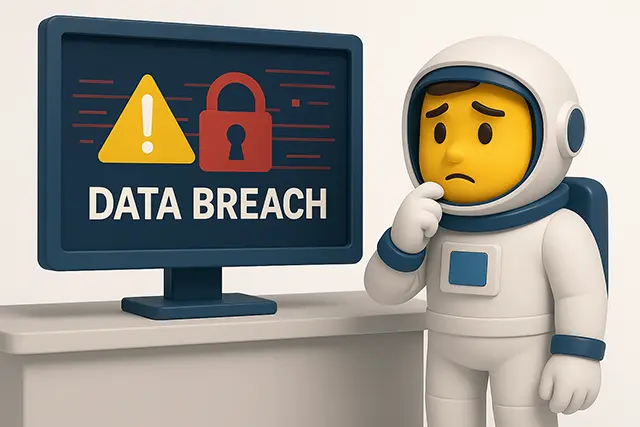Cyber Attack Response Plan: What to Do When You’re Breached

Last Tuesday, I watched a senior IT director stare at her screen for thirty seconds in complete silence. The Grafana dashboard that usually showed healthy green metrics was bleeding red across every service. Her first words weren’t technical commands or panicked orders she simply said, “Well, this is actually happening.” That moment of clarity, when theory becomes reality and all your incident response procedures suddenly matter more than anything else, is what separates organizations that survive breaches from those that become cautionary tales.
In her case, what started as unusual database queries from an internal IP had spiraled into a sophisticated attack that would test every aspect of their cyber crisis management capabilities. Over the next four days, I watched their team transform from shocked individuals into a coordinated response machine. They didn’t just follow their data breach response plan they lived it, adapted it, and ultimately emerged stronger. This is their story, and more importantly, these are the lessons that could save your organization when not if you face your own breach.
When prevention fails, response becomes critical. Your cyber attack response isn’t just about technical recovery it’s about preserving evidence, meeting breach notification requirements, maintaining business operations, and protecting your organization’s reputation. The difference between a manageable incident and a catastrophic breach often comes down to the quality of your incident response procedures in those first crucial hours.
Table of Contents
The Golden Hour: Immediate Actions When Breach Is Suspected
Your cyber incident response begins the moment someone suspects something’s wrong. Like emergency medicine, the first hour often determines the outcome. The biggest mistake I see organizations make during breaches is hesitation waiting for absolute confirmation before activating their response plan. By then, attackers have often expanded their foothold or begun exfiltrating data.
Critical First Steps:
- Activate your response team immediately – Don’t wait for confirmation
- Isolate affected systems – Prevent lateral movement
- Preserve volatile evidence – RAM, network connections, running processes
- Document everything – Start your incident timeline now
- Establish secure communications – Assume primary channels are compromised
Start with containment, not confirmation. Your incident response procedures should prioritize stopping the bleeding before conducting a full diagnosis. This means immediately isolating affected systems, preserving volatile evidence, and activating your response team. You can always scale down if it’s a false alarm, but you can’t recover lost time if you wait too long.
Evidence Collection Script Example:
#!/bin/bash
# Incident Evidence Collection Script
# Run with sudo privileges
INCIDENT_ID="INC-$(date +%Y%m%d-%H%M%S)"
EVIDENCE_DIR="/secure/evidence/$INCIDENT_ID"
# Create evidence directory
mkdir -p $EVIDENCE_DIR
# Capture system state
date > $EVIDENCE_DIR/collection_start.txt
ps aux > $EVIDENCE_DIR/processes.txt
netstat -antp > $EVIDENCE_DIR/network_connections.txt
w > $EVIDENCE_DIR/logged_in_users.txt
# Capture memory (requires LiME or similar)
insmod /path/to/lime.ko "path=$EVIDENCE_DIR/memory.dump format=lime"
# Hash all evidence files
find $EVIDENCE_DIR -type f -exec sha256sum {} \; > $EVIDENCE_DIR/evidence_hashes.txt
echo "Evidence collection complete: $EVIDENCE_DIR"
Document everything from minute one. Your cyber attack response documentation will become crucial for legal proceedings, insurance claims, and regulatory compliance. Create a timeline noting when the incident was discovered, who was notified, what actions were taken, and what evidence was preserved.
Building Your Incident Response Command Structure
Effective cyber crisis management requires clear leadership and defined roles. Your data breach response plan should establish an Incident Commander who has the authority to make critical decisions without bureaucratic delays.
Table: Incident Response Team Roles and Responsibilities
| Role | Primary Responsibilities | Key Decisions |
|---|---|---|
| Incident Commander | Overall coordination, strategic decisions | Escalation, external communications, business continuity |
| Technical Lead | Containment, eradication, recovery | System isolation, restoration priorities |
| Security Analyst | Investigation, threat hunting, forensics | Attack vector identification, IOC development |
| Legal Counsel | Regulatory compliance, evidence preservation | Breach notifications, law enforcement engagement |
| Communications Lead | Internal/external messaging, media relations | Public statements, customer notifications |
| Business Liaison | Impact assessment, continuity planning | Service priorities, workaround authorization |
What I wish every executive understood about cyber incident response is that their role isn’t to manage technical details—it’s to remove obstacles, authorize resources, and make strategic decisions about business continuity. The best executives during a breach ask “What do you need?” not “Why didn’t we prevent this?”
Decision Authority Matrix:
- Incident Commander: Can authorize up to $500K in emergency spending
- Executive Sponsor: Required for public communications or >$500K spending
- Technical Lead: Can isolate any system without prior approval
- Legal Counsel: Veto power on external communications
Evidence Preservation and Forensic Requirements
Your cyber attack response must balance the urgency of containment with the need to preserve evidence. Hasty actions like immediately reimaging infected systems can destroy crucial forensic data needed for attribution, legal proceedings, or insurance claims.
Forensic Collection Priorities:
- Volatile Data (order matters!):
- System memory (RAM)
- Network connections
- Running processes
- Logged-in users
- Open files
- Semi-Volatile Data:
- System logs
- Registry hives (Windows)
- Temporary files
- Browser history
- Non-Volatile Data:
- Hard drive images
- Configuration files
- User data
- Application logs
Create forensic images of affected systems before making any changes. Work with legal counsel to understand evidence requirements for potential litigation. Your data breach response plan should address chain of custody procedures, ensuring that evidence remains admissible in court.
PowerShell Evidence Collection Example:
# Windows Incident Response Collection
$IncidentID = "INC-" + (Get-Date -Format "yyyyMMdd-HHmmss")
$EvidencePath = "E:\Evidence\$IncidentID"
# Create evidence directory
New-Item -ItemType Directory -Path $EvidencePath -Force
# Collect volatile evidence
Get-Process | Export-Csv "$EvidencePath\processes.csv"
Get-NetTCPConnection | Export-Csv "$EvidencePath\network_connections.csv"
Get-WinEvent -FilterHashtable @{LogName='Security';ID=4624,4625} |
Export-Csv "$EvidencePath\login_events.csv"
# Create timeline
$Timeline = @"
Incident ID: $IncidentID
Collection Started: $(Get-Date)
Collected By: $env:USERNAME
System: $env:COMPUTERNAME
"@
$Timeline | Out-File "$EvidencePath\timeline.txt"
Navigating US Breach Notification Requirements
The US regulatory landscape for breach notification requirements is complex and unforgiving. You’re dealing with federal regulations, state laws, and industry-specific requirements, each with different timelines and thresholds.
Table: Key US Breach Notification Timelines
| Regulation | Notification Timeline | Who Must Be Notified | Threshold |
|---|---|---|---|
| SEC (Public Companies) | 4 business days | SEC via 8-K filing | Material incidents |
| HIPAA | 60 days | HHS, affected individuals | 500+ records |
| GLBA | “As soon as possible” | Customers, regulators | Any unauthorized access |
| State Laws (Fastest) | 72 hours (varies) | Affected residents, AG | Varies by state |
| GDPR (if applicable) | 72 hours | Supervisory authority | Risk to rights/freedoms |
| PCI DSS | Immediately | Card brands, acquirer | Any cardholder data |
At the federal level, your cyber attack response must consider SEC requirements for public companies, HIPAA for healthcare data, and GLBA for financial information. The SEC now requires disclosure of material cybersecurity incidents within four business days, dramatically compressing your response timeline.
State-Specific Considerations:
- California: “Without unreasonable delay” + AG notification if 500+ residents
- New York: “Without unreasonable delay” + specific content requirements
- Texas: 60 days + AG notification required
- Florida: 30 days for 500+ residents
- Illinois: “Without unreasonable delay” + specific data elements trigger
Your incident response procedures must enable rapid assessment of materiality and disclosure obligations. Consider specific response considerations for ransomware attacks, data breaches, and insider threats.

Communication Strategies During Active Incidents
Communication during a cyber incident response is a delicate balance. Say too little, and you appear evasive. Say too much, and you might compromise the investigation or create legal liability.
Internal Communication Protocol:
- Hour 0-2: Core response team only
- Hour 2-6: Department heads on need-to-know basis
- Hour 6-12: All-hands notification if business impact
- Hour 12+: Regular updates every 4-6 hours
Communication Channels Priority:
- Primary: Dedicated incident response Slack/Teams channel
- Backup: Signal or WhatsApp group
- Emergency: Phone tree with personal cell numbers
- Never Use: Email (potentially compromised)
External communication requires even more finesse. Your cyber attack response shouldn’t include public statements until you understand the incident’s scope and have legal approval. When dealing with DDoS attacks or supply chain attacks, public visibility may force earlier disclosure.
Sample Initial Notification Template:
Subject: Important Security Update - [Company Name]
Dear [Stakeholder],
We recently discovered a security incident affecting our systems.
We immediately activated our incident response procedures and are
working with leading cybersecurity experts to investigate.
What We Know:
- Incident discovered: [Date/Time]
- Systems affected: [General description]
- Data potentially impacted: [If known]
What We're Doing:
- Contained the incident
- Launched full investigation
- Notifying affected parties
- Working with law enforcement
What You Should Do:
- [Specific actions]
- Monitor accounts
- Contact us with questions at [dedicated email/phone]
We take this matter extremely seriously and will provide updates
as our investigation progresses.
[Executive Name]
[Title]
Business Continuity During and After the Attack
Your cyber incident response isn’t just about stopping the attack it’s about keeping your business running. The most sophisticated data breach response plan is worthless if your organization can’t serve customers or meet critical obligations during the incident.
Business Impact Quick Assessment:
- Critical (Must restore in <4 hours):
- Payment processing
- Customer authentication
- Emergency communications
- High (Restore in <24 hours):
- Order management
- Inventory systems
- Financial reporting
- Medium (Restore in <72 hours):
- Marketing systems
- HR platforms
- Development environments
Workaround Decision Tree:
Can the system run in degraded mode?
├─ Yes → Implement limited functionality
│ └─ Document limitations for users
└─ No → Manual process available?
├─ Yes → Train staff on manual procedures
└─ No → Redirect to alternate service
└─ Communicate change to customers
Recovery prioritization is crucial for effective cyber attack response. Not all systems are equally important. For malware attacks or phishing incidents, focus on preventing reinfection before restoration.
Meeting Regulatory Deadlines and Documentation Requirements
Your breach notification requirements create hard deadlines that don’t care about your investigation’s complexity. US regulations are particularly stringent, with some requiring notification within 72 hours of discovery.
Documentation Checklist:
- Initial detection timestamp and method
- Systems and data affected
- User/record count estimates
- Attack vector (if known)
- Containment actions taken
- Evidence preserved
- Notifications sent (who, when, how)
- Remediation steps completed
- Ongoing monitoring implemented
Regulatory Filing Templates:
Create pre-approved templates for:
- SEC 8-K filings
- State AG notifications
- Customer breach letters
- Media statements
- Employee communications
Document your decision-making process, especially when determining whether an incident triggers breach notification requirements. Regulators will scrutinize not just what you decided but how you decided it.
Post-Incident Analysis and Improvement
After the immediate crisis passes, your cyber incident response enters its most valuable phase: learning. The post-incident analysis determines whether you’ll face the same attack again or emerge stronger.
Post-Incident Review Framework:
- Technical Analysis:
- Root cause identification
- Security control gaps
- Detection failures
- Response time analysis
- Process Evaluation:
- Communication effectiveness
- Decision-making speed
- Resource availability
- Third-party coordination
- People Assessment:
- Training gaps
- Role clarity
- Stress management
- Team performance
Update your incident response procedures based on lessons learned. Every real incident reveals gaps between plan and reality. Whether responding to zero-day exploits or man-in-the-middle attacks, each incident teaches valuable lessons.
Building Resilience Through Tabletop Exercises
The worst time to test your cyber crisis management capabilities is during an actual crisis. Regular tabletop exercises help teams understand their roles, identify plan gaps, and build the muscle memory needed for effective response.
Quarterly Exercise Schedule:
- Q1: Ransomware scenario
- Q2: Data breach with regulatory focus
- Q3: Insider threat
- Q4: Supply chain compromise
Exercise Metrics to Track:
- Time to detection
- Time to containment
- Decision accuracy
- Communication effectiveness
- Regulatory compliance
- Business impact minimization
Include external stakeholders in some exercises. Your cyber incident response doesn’t happen in isolation you’ll need to coordinate with law enforcement, regulators, customers, and potentially the media.
Frequently Asked Questions
How quickly should we activate our cyber attack response plan?
Immediately upon credible suspicion of an incident. It’s better to stand down a response team than to lose critical hours. Most successful responses begin within 15 minutes of initial detection.
What’s the biggest mistake organizations make in breach notification requirements?
Underestimating the geographic scope. A breach affecting just 100 customers could trigger notification requirements in 20+ states if those customers are distributed. Always map affected individuals to their state of residence early in your investigation.
Should we pay ransomware demands during our incident response procedures?
This requires executive and legal consultation. Consider cyber insurance coverage, data backup status, and potential sanctions issues. The FBI discourages payment, but business continuity may force difficult decisions. See our guide on ransomware attacks for detailed considerations.
How do we handle cyber crisis management if our security team is small?
Pre-arrange support through incident response retainers, cyber insurance providers, or managed security services. Document clear escalation criteria so even junior staff know when to call for help. Small teams especially benefit from automation and clear playbooks.
What evidence is legally required for our data breach response plan?
At minimum: proof of what data was accessed, when the breach occurred, how it happened, and who was affected. Consult legal counsel for your industry’s specific requirements. Over-collection is better than under-collection for evidence.
How do we balance transparency with legal liability in communications?
Work closely with legal counsel to develop factual statements that acknowledge the incident without admitting fault or speculating about impact. Use phrases like “unauthorized access” rather than “breach” until facts are confirmed.
When should we engage law enforcement in our cyber incident response?
Immediately for suspected nation-state attacks, when required by regulation (like CIRCIA), or when you need assistance with attribution and prosecution. The FBI and Secret Service have specialized cybercrime units that can assist without taking over your response.
Preparing for Tomorrow’s Incidents Today
Your cyber attack response capability is a living system that requires constant evolution. As attack techniques grow more sophisticated and breach notification requirements become more stringent, your incident response procedures must adapt accordingly. The question isn’t whether you’ll face another incident it’s whether you’ll be better prepared than last time.
Success in cyber incident response comes from preparation, practice, and continuous improvement. By building comprehensive response procedures, understanding your regulatory obligations, and learning from each incident, you transform cyber crisis management from a chaotic scramble into a coordinated response.
For authoritative guidance, refer to NIST’s Incident Response Guide (SP 800-61r3) and CISA’s Incident Response Resources. These frameworks provide tested methodologies that complement your organization-specific procedures.
Here’s a truth I learned after managing dozens of incidents: the best responders aren’t the ones who never sweat they’re the ones who’ve practiced sweating. They’ve felt the adrenaline rush of a tabletop exercise, made mistakes in simulations, and learned which coffee shop near the office stays open all night. They know that incident response is ultimately about people helping people through a crisis.
Your future self will thank you for every hour spent preparing today. Because somewhere out there, an attacker is planning their next move. They’re counting on you being unprepared, understaffed, or overwhelmed. Prove them wrong. Build a cyber attack response capability that turns their sophisticated attack into your Tuesday afternoon drill.
Remember, specific response considerations vary by attack type. Your response plan should be flexible enough to handle various scenarios while maintaining the structure needed for effective crisis management. The goal isn’t to prevent every incident it’s to respond so effectively that incidents become manageable events rather than existential crises. After all, in cybersecurity, it’s not about if you’ll face an incident it’s about being the team everyone else wishes they had when crisis strikes.







